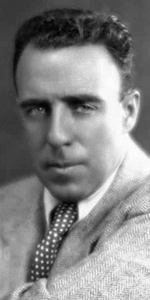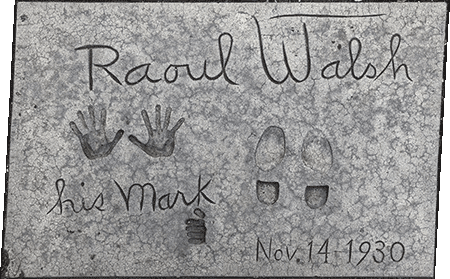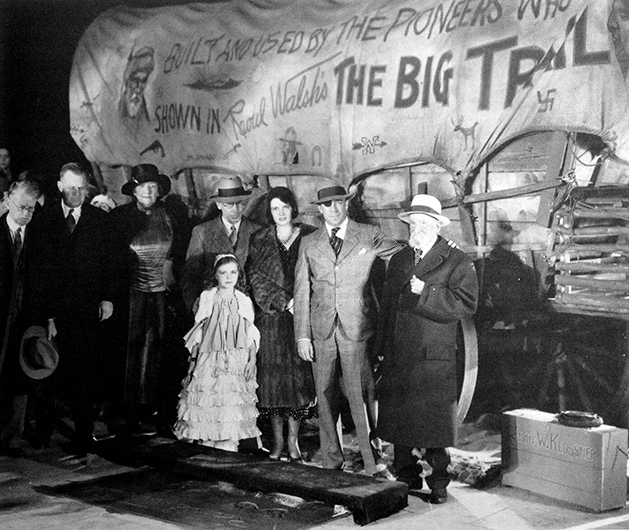|
 |
 |
 |
 |
 |
 |
 |
| Raoul Walsh, date unknown. |
| |
|
 |
|
 |
|
|
| Raoul Walsh |
 |
| Forecourt Ceremony held on Friday, November 14, 1930 |
| |
Born: March 11, 1887, in New York City, New York
Age at the time of the ceremony: 43
Died: December 31, 1980, in Simi Valley, California, age 93 |
| |
Raoul Walsh was the first film director to have his imprints taken for the Chinese Theatre Forecourt, and this says a good deal about his stature among film personalities. An actor originally, Walsh had a long career as a director, which generated some signifigant films. His ceremony was the the first to be connected to a film playing at the Chinese, in this case, Walsh's film The Big Trail, which had its World Premiere at the theatre on October 2, 1930.
Born to an Irish mother and English father, Walsh grew up in comfotable circumstances in New York City, where the Walsh family was friendly with the Barrymore family, which must have influenced young Raoul toward the stage. After graduating from Seaton Hall, Walsh hit the ground running, co-directing a documentary of the then-current Mexican Revolution, The Life of Villa for Biograph in 1912.
By 1914, working for the Mutual Film Corp. and working with D. W. Griffith, Walsh returned to Mexico to shoot a documentary with recreated scenes they called The Life of General Villa (released in May 1914). Poncho Villa played himself, but Walsh played him as a younger man! Becoming close to Griffith, Walsh was an assistant director and played the role of John Wilkes Booth in The Birth of a Nation (released in March 1915).
Walsh continued to act until enlisting in the Army during World War I. Following the war, Walsh jumped right back in, eventually directing Douglas Fairbanks in The Thief of Bagdad (released in March 1924). |
|
|
|
|
| |
 |
 |
| Grauman's Chinese Theatre, Hollywood, California. Raoul Walsh Forecourt block. Executed by Jean Klossner, Friday, November 14, 1930. 57 x 38 inches overall. |
 |
|
 |
|
 |
Many similar hard-charging films came after that: What Price Glory (released in November 1926), was so successful, it spawned several sequels; he directed and acted in the first film of the Sadie Thompson story with Gloria Swanson (released in January, 1928).
Walsh lost the use of his right eye when a jackrabbit stattered his windshield while he was scouting locations for In Old Arizona (released in January 1928). He wore an eyepatch from then on.
More hits for Fox followed: The Cock Eyed World (which played the Chinese in September 1929), The Big Trail, filmed in 70mm (and played the Chinese in October 1930), and was playing at the theatre when the footprinting ceremony was held), and For Me and My Gal in (released in December 1932).
Walsh was loaned out a good deal, making The Bowery with Wallace Beery (released in October 1933) for 20th Century, Going Hollywood with Marion Davies (released in December 1933) at M-G-M, Every Night at Eight with George Raft (released in August 1935) for Paramount, Klondike Annie with Mae West (released in February 1936), at Paramount, You're in the Army Now with Wallace Ford (released in April 1937), made for Gaumount British in 1937, the comedy Artists and Models with Jack Benny (released in August 1937), for Paramount; Walsh even got to write some of the songs for the musical St. Louis Blues with Dorothy Lamour (released in February 1939), for Paramount.
But it wasn't until Walsh signed a contract to direct films for Warner Bros. that what could be considered his best films could come about. The studio wanted them fast and tough, and Walsh delivered with films like The Roaring Twenties (released in October 1939), They Drive By Night (released in August 1940), High Sierra (released in January 1941), the wildly inaccurate account of George Armstrong Custer's death in They Died with Their Boots On (released in January 1941), Gentleman Jim (released in November 1942), Objective, Burma! (released in February 1945) and what many people feel is Walsh's best film, White Heat in (released in September 1949).
With television as competition, Walsh stepped up his game, directing Captain Horatio Hornblower (released in April 1951), A Lion is in the Streets (released in September 1953), Battle Cry (released in February 1955), The Naked and the Dead (released in August 1958) and Esther and the King (which played the Chinese in November 1960).
Ever active after his last film in 1964, Walsh lived to the age of 93, at his ranch in Simi Valley California. |
|
|
|
|
 |
 |
| Grauman's Chinese Theatre, Hollywood, California. Raoul Walsh Forecourt ceremony, Friday, November 14, 1930. To help with the proceedings, the Fox studio brought out a wagon used in and cast members from The Big Trail along with (left to right) Harry E. Jones, president of the Hollywood Chamber of Commerce, Dr. John C. Parrish, president of the California Historical Society, Joseph Meller, president of the California Pioneer Association, actors Louise Carver, Tully Marshall, Helen Parrish, Marguerite Churchil, and Raoul Walsh. On the right, is 87-year-old Thomas C. Hull, California Pioneer. On the extreme right is cement artist Jean Klossner's valise. |
 |
|
|
|
 |
|
 |
|
|